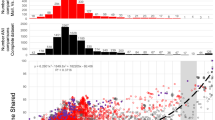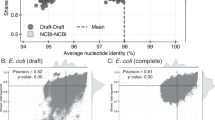Abstract
Genomic and metagenomic data indicate a high degree of genomic variation within microbial populations, although the ecological and evolutive meaning of this microdiversity remains unknown. Microevolution analyses, including genomic and experimental approaches, are so far very scarce for non-pathogenic bacteria. In this study, we compare the genomes, metabolomes and selected ecological traits of the strains M8 and M31 of the hyperhalophilic bacterium Salinibacter ruber that contain ribosomal RNA (rRNA) gene and intergenic regions that are identical in sequence and were simultaneously isolated from a Mediterranean solar saltern. Comparative analyses indicate that S. ruber genomes present a mosaic structure with conserved and hypervariable regions (HVRs). The HVRs or genomic islands, are enriched in transposases, genes related to surface properties, strain-specific genes and highly divergent orthologous. However, the many indels outside the HVRs indicate that genome plasticity extends beyond them. Overall, 10% of the genes encoded in the M8 genome are absent from M31 and could stem from recent acquisitions. S. ruber genomes also harbor 34 genes located outside HVRs that are transcribed during standard growth and probably derive from lateral gene transfers with Archaea preceding the M8/M31 divergence. Metabolomic analyses, phage susceptibility and competition experiments indicate that these genomic differences cannot be considered neutral from an ecological perspective. The results point to the avoidance of competition by micro-niche adaptation and response to viral predation as putative major forces that drive microevolution within these Salinibacter strains. In addition, this work highlights the extent of bacterial functional diversity and environmental adaptation, beyond the resolution of the 16S rRNA and internal transcribed spacers regions.
Similar content being viewed by others
Log in or create a free account to read this content
Gain free access to this article, as well as selected content from this journal and more on nature.com
or
Accession codes
Accessions
GenBank/EMBL/DDBJ
References
Abby S, Daubin V . (2007). Comparative genomics and the evolution of prokaryotes. Trends Microbiol 15: 135–141.
Acinas SG, Klepac-Ceraj V, Hunt DE, Pharino C, Ceraj I, Distel DL et al. (2004). Fine-scale phylogenetic architecture of a complex bacterial community. Nature 430: 551–554.
Antón J, Oren A, Benlloch S, Rodríguez-Valera F, Amann R, Rosselló-Mora R . (2002). Salinibacter ruber gen. nov., sp. nov., a novel, extremely halophilic member of the Bacteria from saltern crystallizer ponds. Int J Syst Evol Microbiol 52: 485–491.
Antón J, Peña A, Santos F, Martínez-García M, Schmitt-Kopplin P, Rosselló-Mora R . (2008). Distribution, abundance and diversity of the extremely halophilic bacterium Salinibacter ruber. Saline Syst 4: 1–10.
Aziz RK, Bartels D, Best AA, DeJongh M, Disz T, Edwards RA et al. (2008). The RAST server: rapid annotations using subsystems technology. BMC Genomics 9: 75.
Carbone A, Zinovyev A, Kepes F . (2003). Codon adaptation index as a measure of dominating codon bias. Bioinformatics 19: 2005–2015.
Cohan FM, Koeppel AF . (2008). The origins of ecological diversity in prokaryotes. Curr Biol 18: R1024–R1034.
Coleman ML, Sullivan MB, Martiny AC, Steglich C, Barry K, DeLong EF et al. (2006). Genomic islands and the ecology and evolution of Prochlorococcus. Science 311: 1768–1770.
Cuadros-Orellana S, Martín-Cuadrado AB, Legault B, D’Auria G, Zhaxybayeva O, Papke RT et al. (2007). Genomic plasticity in prokaryotes: the case of the square haloarchaeon. ISME J 1: 235–245.
Dobrindt U, Hochhut B, Hentschel U, Hacker J . (2004). Genomic islands in pathogenic and environmental microorganisms. Nat Rev Micro 2: 414–424.
Doolittle WF, Zhaxybayeva O . (2009). On the origin of prokaryotic species. Genome Res 19: 744–756.
Feil EJ . (2004). Small change: keeping pace with microevolution. Nat Rev Microbiol 2: 483–495.
Fleischmann RD, Adams MD, White O, Clayton RA, Kirkness AR, Bult CJ et al. (1995). Whole-genome random sequencing and assembly of Haemophilus influenzae Rd. Science 269: 496–512.
Fraser C, Hanage WP, Spratt BG . (2007). Recombination and the nature of bacterial speciation. Science 315: 476–480.
Guixa-Boixareu N, Calderón-Paz JI, Heldal M, Bratbak G, Pedrós-Alió C . (1996). Viral lysis and bacterivory as prokaryotic loss factors along a salinity gradient. Aquat Microb Ecol 11: 215–227.
Huerta-Cepas J, Bueno A, Dopazo J, Gabaldón T . (2008). PhylomeDB: a database for genome-wide collections of genes phylogenies. Nucl Acids Res 36: D491–D496.
Hunt ED, David LA, Gevers D, Preheim SP, Alm EJ, Polz MF . (2008). Resource partitioning and sympatric differentiation among closely related bacterioplankton. Science 320: 1081–1085.
Huson DH, Bryant D . (2006). Application of phylogenetic networks in evolutionary studies. Mol Biol Evol 23: 254–267.
Ivars-Martínez E, Martín-Cuadrado AB, D’Auria G, Mira A, Ferriera S, Johnson J et al. (2008). Comparative genomics of two ecotypes of the marine planktonic copiotroph Alteromonas macleodii suggests alternative lifestyles associated with different kinds of particulate organic matter. ISME J 2: 1194–1212.
Jordan IK, Rogozin IB, Wolf YI, Koonin EV . (2002). Microevolutionary genomics of bacteria. Theor Popul Biol 61: 435–447.
Meddini D, Donati C, Tettelin H, Masignani V, Rappuoli R . (2005). The microbial pan-genome. Curr Opin Genet Dev 15: 589–594.
Mongodin EF, Nelson KE, Daugherty S, DeBoy RT, Wister J, Khouri H et al. (2005). The genome of Salinibacter ruber: convergence and gene exchange among hyperhalophilic bacteria and archaea. Proc Natl Acad Sci USA 102: 18147–18152.
Papke RT, Koening JE, Rodríguez-Valera F, Doolittle WF . (2004). Frequent recombination in a saltern population of Halorubrum. Science 306: 1928–1929.
Pedrós-Alió C . (2006). Marine microbial diversity: can it be determined? Trends Microbiol 14: 257–263.
Peña A, Valens-Vadell M, Santos F, Buczolits S, Antón J, Kämpfer P et al. (2005). Intraspecific comparative analysis of the species Salinibacter ruber. Extremophiles 9: 151–161.
Polz MF, Hunt DE, Preheim SP, Weinreich DM . (2006). Patterns and mechanisms of genetic and phenotypic differentiation in marine microbes. Phil Trans R Soc B 361: 2009–2021.
Rocha EPC, Smith JM, Hurst LD, Holden MTG, Cooper JE, Smith NH et al. (2006). Comparisons of dN/dS are time dependent for closely related bacterial genomes. J Theor Biol 239: 226–235.
Rodríguez-Valera F, Martín-Cuadrado AB, Rodríguez-Brito B, Pasić L, Thingstad TF, Rohwer F et al. (2009). Explaining microbial population genomics through phage predation. Nat Rev Microbiol 7: 828–836.
Rosselló-Mora R, Lucio M, Peña A, Brito-Echeverría J, López-López A, Valens-Vadell M et al. (2008). Metabolic evidence for biogeographic isolation of the extremophilic bacterium Salinibacter ruber. ISME J 2: 242–253.
Sikorski J . (2008). Populations under microevolutionary scrutiny: what will we gain? Arch Microbiol 189: 1–15.
Suhre K, Schmitt-Kopplin P . (2008). MassTRIX: mass translator into pathways. Nucl Acids Res 36: W481–W484.
Thomson JR, Pacocha S, Pharino C, Klepac-Ceraj V, Hunt DE, Benoit J et al. (2005). Genotypic diversity within a natural coastal bacterioplankton population. Science 307: 1311–1313.
Whilhelm LJ, Tripp HJ, Givan SC, Smith DP, Giovannoni SJ . (2007). Natural variation in SAR11 marine bacterioplankton genomes inferred from metagenomic data. Biol Direct 2: 19.
Wilmes P, Simmons SL, Denev VJ, Banfield JF . (2008). The dynamic genetic repertoire of microbial communities. FEMS Microbiol Rev 33: 109–132.
Acknowledgements
We warmly thank Carlos Pedrós-Alió and Johaness Sikorski for the critical reading of a previous version of the paper and their many helpful suggestions and discussion. This work was funded by projects CGL2006-12714-CO2-01 and 02 from de Spanish Ministry of Science (to JA and RRM). J Dopazo thanks the National Institute of Bioinformatics (www.inab.org), that is a platform of Genoma España. This work was financially supported by the Max Plank Society within the projects Marine Genomics and EnviTools.
Author information
Authors and Affiliations
Corresponding author
Additional information
Supplementary Information accompanies the paper on The ISME Journal website
Rights and permissions
About this article
Cite this article
Peña, A., Teeling, H., Huerta-Cepas, J. et al. Fine-scale evolution: genomic, phenotypic and ecological differentiation in two coexisting Salinibacter ruber strains. ISME J 4, 882–895 (2010). https://doi.org/10.1038/ismej.2010.6
Received:
Revised:
Accepted:
Published:
Issue date:
DOI: https://doi.org/10.1038/ismej.2010.6
Keywords
This article is cited by
-
Toward quantifying the adaptive role of bacterial pangenomes during environmental perturbations
The ISME Journal (2022)
-
Combination of statistical methods for easy analysis and classification of virus–host environmental dynamics in the saltern of Sfax, Tunisia
Euro-Mediterranean Journal for Environmental Integration (2022)
-
Metabolic diversity and co-occurrence of multiple Ferrovum species at an acid mine drainage site
BMC Microbiology (2020)
-
Genomic variation and biogeography of Antarctic haloarchaea
Microbiome (2018)
-
Characterization of ecologically diverse viruses infecting co-occurring strains of cosmopolitan hyperhalophilic Bacteroidetes
The ISME Journal (2018)



